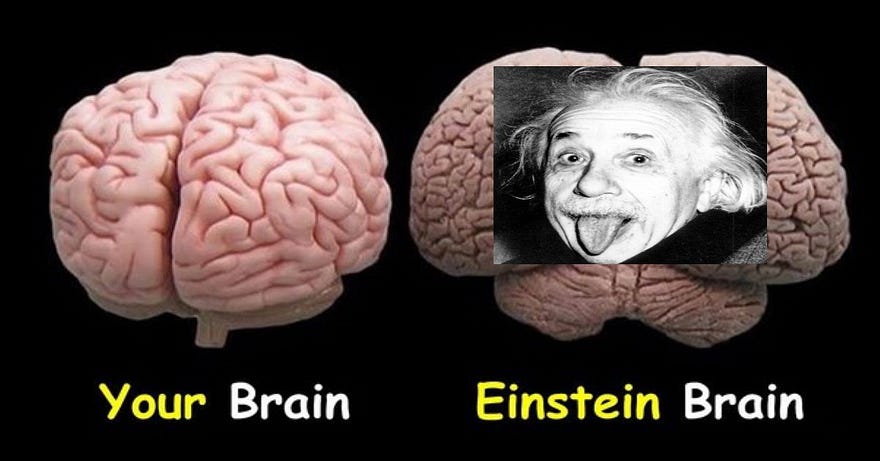There’s been a lot of excited and curious talk about Albert Einstein’s brain over the decades. Or, more correctly, there’s been a lot of talk about the size of Einstein’s brain. So does size matter?

Clearly, there’s often been the following underlying assumption when it comes to the many (often silly) discussions of the size of Einstein’s brain:
big brain = big intelligence
It may seem logical to assume that a big brain means a big intelligence… That’s until one starts to use one’s own intelligence to think about this issue.
The other extreme position is that it’s all down to how each brain is actually (as it were) used by its owner. Relatedly, it’s also said to be down to the environments in which each brain finds itself (e.g., parental surroundings, relative wealth or poverty, influence of peers, society, culture, etc.). However, this way of looking at brains may go too far as well.
So, like the endless nature versus nurture debate, it may not be a case of either/or. That is, it may not all boil down to having a big brain or all boil down to how that brain is used. That said, it may not be 50/50 either. (It may not be any other decipherable proportion.) In other words, it may be very difficult to distinguish how important brain size (as well as other aspects of the brain) has been from the environmental factors (along with how brains are used) which have impinged on that brain.
Let’s return to the size of the brain.
In the animal kingdom, some creatures with large brains are (or sometimes may simply seem) dumber than some creatures with smaller brains. Susan Blackmore (in her piece ‘Why aren’t animals with larger brains more intelligent than us?’), for example, sums up this position with these words:
“Bigger isn’t always better. Sometimes how you use it is more important than what you’ve got. There are two reasons. First, brain structure is more important than brain size, and human brains with their highly folded and complicated cortex can do things no other brains can.”
So it all depends on a hell of a lot more than merely the size of the brain.
Yet the size of a brain must surely be relevant!
[See the article ‘Do bigger brains make smarter carnivores?’, which answers its own question: “Yes.”]
Indeed, the stress on the size of the brains of Homo sapiens (i.e., you and I) and other animals has been very apparent over the years in biology, neuroscience and evolutionary theory. However, note here that all this has been about the size of the brain of different species (including Homo sapiens), not the size of the brain of individuals within each species.
The New Scientist on Einstein’s Brain
This essay began as a gut reaction to a New Scientist book in which there’s an aside (i.e., it appears in a box next to the main text) on Albert Einstein’s brain.
It would be silly to be too critical of a mere aside in a book which has ‘Einstein’s Relativity’ (i.e., not ‘Einstein’s Brain’) as a subheading. (The book is called Where the Universe Came From.) In other words, the words were written by a writer on physics (or by an actual physicist), not a writer on neuroscience (or an actual neuroscientist). Still, this boxed section captures some of the (possible) mistakes one often finds when Einstein’s brain is discussed… as it often is!
Firstly, this section (in the aforementioned book) tells us that Einstein’s brain was “initially something of a disappointment, being slightly smaller than average”.
These words sum up the large brain=large intelligence assumption of so many people.
Yet this section also states the following:
“A 1999 study showed that Einstein’s parietal lobe, the area of the brain associated with mathematics and spatial reasoning, was 15 per cent wider than in a normal brain.”
[Did this writer mean “average brain” by “normal brain” in the second quote?]
If this study — as well as other studies — was a comparison of Einstein’s brain with average (or “normal”) brains, then it wouldn’t have been a comparison with the brains of other scientists (e.g., those who also did lots of mathematical and spatial reasoning). So although Einstein’s parietal lobe might have been “wider” than the average person’s (or at least the very-limited number of brains also studied in this example), then it might not have been wider than the brains of other physicists or mathematicians.
Now another question can be asked here.
Did Einstein’s parietal lobe become wider as a result of such “mathematics and spatial reasoning”, or did it actually enable Einstein to excel at spatial reasoning and mathematics in the first place?
Indeed, what about both possibilities?
Perhaps Einstein’s brain became wider as a result of his extensive spatial reasoning, etc., and it might also have been wider from birth.
This becomes relevant in light of another New Scientist comment:
“The researchers also noticed a large knob on his motor cortex, representing Einstein’s early practice playing the violin.”
One wonders if there are also “large knobs” for excessive masturbation, knitting, kicking people’s heads in, reading Medium every day, etc. That is, surely not every excessive and/or specialised activity has its own (well) knob in the brain.
Indeed, the very idea of a large knob “representing Einstein’s early practice playing the violin” seems too (as it were) particular.
If Einstein had a large knob for (or as a result of) playing the violin, then did he also have a large knob for (or a result of) playing bowls? (Let’s just pretend that Einstein played bowls every day.) Unless, that is, Einstein’s large knob didn’t only “represent” violin-playing: it might also have represented (or perhaps neuro-physically underpinned) the playing of any musical instrument — and indeed other cognitive activities too. Perhaps this large knob in Einstein’s brain represented some kind of “music module” which was only contingently expressed in terms of playing the violin.
What’s more, even though many neuroscientists and philosophers accept the existence of what they call “modules” (see ‘Modularity’ and ‘Modularity of Mind’), they don’t also believe that modules exist as physical knobs (or at precise locations) in the brain. Holistically speaking, modules may not be instantiated in particular areas (or parts) of the brain at all.
[To see another perspective on this, see ‘The Brain Is Not Modular: What fMRI Really Tells Us’.]
Other Studies of Einstein’s Brain
There are lots of odd things about Einstein’s brain.
Then again, odd things can be found in literally every other brain.
So all this will at least partly depend on the word “odd”, as well as on context and comparisons.
Take the position of neurologist Terence Hines of Pace University.
He’s critical of most of the studies of Einstein’s brain. He believes that they're flawed. (Some “studies” have been based solely on photos of Einstein’s brain!)
Terence Hines also argues that all human brains are “unique” in their own ways. That is, if you take a random brain and then study it, then you’ll find that it’s different from other brains (i.e., in either large or small ways). Thus, Hines is suspicious of the many wild jumps from the (possibly) unique features of Einstein’s brain… to his genius.
Of course, not many other brains have been studied and discussed in so much detail.
In terms of that detail.
One study (‘The exceptional brain of Albert Einstein’) had it that Einstein had no parietal operculum in either hemisphere. (This finding has been, rather predictably, disputed — see here.) Another study had it that Einstein’s brain showed an enlarged Sylvian fissure…
An enlarged Sylvian bloody fissure! Wow!…
Seriously, so what?
And so on and so on.
So what does all this data (even if accurate) actually mean?
As Professor Laurie Hall (of Cambridge University) put it about a single study of Einstein’s brain (i.e., which linked part of Einstein’s brain to some characteristic of his intelligence or “genius”):
“To say there is a definite link is one bridge too far, at the moment. So far, the case isn’t proven.”
It’s also notable how often words like “may” are used in these studies of Einstein’s brain.
Specifically, take this passage from Professor Sandra Witelson (as published in The Lancet):
“This unusual brain anatomy [e.g., the missing part of the Sylvian fissure] may explain why Einstein thought the way he did.”
We also have this from Dr. Dahlia W. Zaidel:
“The larger neurons in the left hippocampus imply that Einstein’s left brain may have had stronger nerve cell connections between the hippocampus and another part of the brain called the neocortex than his right.”
Thus, we keep seeing phrases like “it could be”, “it may be”, “it’s possible that”, etc. in these studies of Einstein’s brain. That said, these phrases occur all the time in scientific studies. So surely that means that they’re not always (or necessarily) suspect in nature.
What’s more, it’s precisely because Einstein’s brain became such a sexy subject that some critical researchers have picked up on what’s called unconscious bias and impartial research.
Simple flaws have also been detected in many of the studies of Einstein’s brain…
That said, there are probably flaws in all scientific studies.
Now add to all that the phenomenon of publication bias, which is often blatant when it comes to Einstein’s brain.
The most frequent and obvious case of such bias is that scientific — and most definitely newspaper — publications will get excited about the differences between Einstein’s brain and the brains of mere mortals like the readers of this essay. Yet they’ll also ignore any data which shows us how similar Einstein’s brain was to the average brain — that’s if there even is such a thing!
My flickr account:









No comments:
Post a Comment